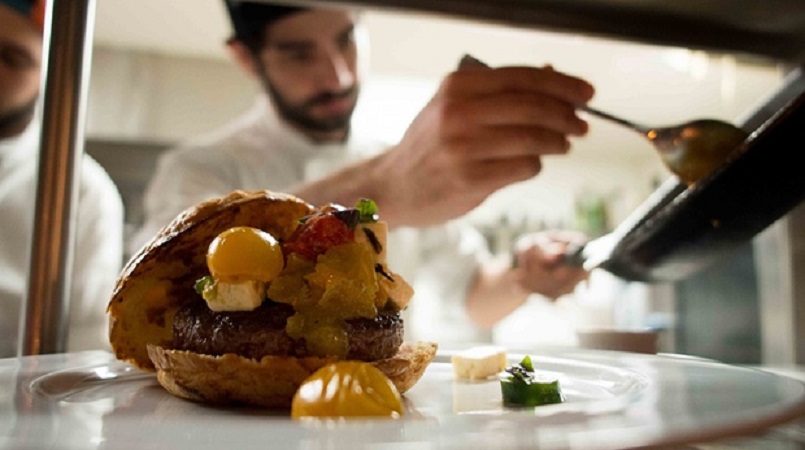
When people think of an ant in the kitchen, it is probably of an uninvited little insect painstakingly transporting food remains to its colony.
But this concept might soon change.
Brazilian top chefs are leading a gastronomic revolution by including bugs and other Amazonian ingredients, cooked with pioneering techniques, into their sophisticated menus, in a move that acknowledges the value of Brazil’s native food culture.
As with Ferran Adria’s molecular gastronomy revolution in the 90s, or Noma’s flowers and uncommon plants, this could eventually be imitated and lead to a wider use of insects in the human diet.
Alex Atala, chef and owner of São Paulo’s D.O.M., ranked the ninth best restaurant in the world, was the first to break the unwritten rules of high-end gastronomy when he served a raw Amazonian leaf-cutter ant on a pineapple cube as one of the desserts from his $200 tasting menu.
Atala, a passionate researcher of Brazil’s Amazonian food, discovered edible ants when he traveled to São Gabriel das Cachoeiras, a remote region in the Amazon state where experts say natives have been consuming insects “from time immemorial”.
“An old woman came to me and offered me a bowl of ants. I found the taste amazing, similar to ginger,” says the double Michelin-starred chef and co-founder of Instituto ATÁ, an organisation that works with small-scale food producers to help them be sustainable.
The home of the ants
Atala’s encounter with creepy-crawlies in São Gabriel das Cachoeiras was not a coincidence. Bordering with Colombia and Venezuela, this is considered one of the richest municipalities on earth for ethnic diversity, according to Almir Von Held, a scholar working for Brazil’s National Indian Foundation (FUNAI, in Portuguese). “There are over 20 indigenous groups and many consume ants, as insects provide valuable and healthy animal protein”, he says.
“We are still missing a reliable theory to explain when the consumption of ants started in Brazil. But the São Gabriel das Cachoeiras’ region is probably one of the places where all this started, much earlier than when the colonisers arrived to America,” says Von Held, who has worked for more than 35 years researching Brazil’s indigenous groups and has spent several years living with Brazilian native’s tribes in far-off territories.
“I saw there the Baniwa tribe consuming raw ants, and they also cook them. Originally, they were eating them only when they were with members of the clan, or in private if a non-native was present, because they felt shame. But now that ants are becoming popular in urban areas they do not hide anymore.”
Disgust towards eating insects in South America, where many associate their consumption with poor populations, probably originated in Western societies. Elsewhere, however, their consumption is much more common: in China, for instance, scorpions are served as snacks in brochette, while in Mexico roasted crickets fill tacos and season guacamole.
This lends itself to a gastronomic heritage sometimes linked with the fact that, in the past, some societies had limited access to animal protein from beef or poultry. In a world now dealing with the challenges of a fast growing population, the old solution of eating insects may well reappear.
In a landmark report in 2013, the Food and Agriculture Organisation (FAO) has argued that eating bugs was both healthy and environmentally friendly. “On average, insects use just 2kg of feed to produce 1kg of insect meat. Cattle, at the other end of the spectrum, require 8kg of feed to produce 1kg of beef,” the document stated. It identified 1,900 insect species currently consumed by humans worldwide.
The ant burger
For those reluctant to eat insects on their own, São Paulo’s restaurant scene is offering a soft landing experience. The burger bar Meats, founded by the 26-year-old Brazilian chef Paulo Yoller, offers a fat-free meat burger seasoned with vinaigrette of ants.
“Here in Brazil most chefs copy what is done in Italy, Spain or France, but I believe in genuine Brazilian gastronomy. This is why I combine aboriginal food ingredients with fast food recipes”, says Yoller, who regularly makes trips to Amazonian regions in search of new ideas.
Ants are far from being commercialised in Brazil and it is still too soon to say if they will become a mainstream ingredient in local diets. But the ant recipes proposed by Yoller and Atala have quickly captured the attention of São Paulo’s media and public, with queues of up to two hours on Friday and Saturday nights for a table at Yoller’s restaurant.
